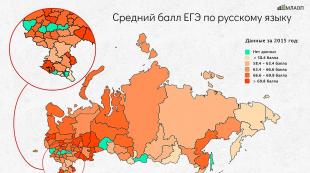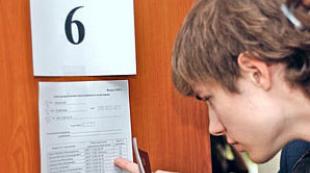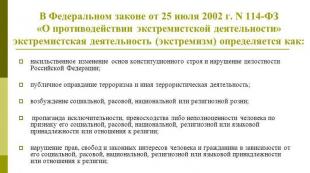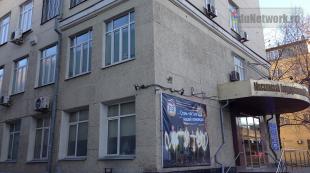What is active transport in biology. Passive and active transport. Sodium and potassium pump
Active transport is called processes in which the molecule should move through the membrane, regardless of the direction of its concentration gradient. Most often it occurs, IC region with a lower concentration into an area with higher and is accompanied by an increase in free energy, which is 5.71 LGC2 / C | KJ-Mol-1.
As indicated earlier, this process of transferring substances from places with a smaller value of electrochemical potential in places with its large value.
Since the active transport in the membrane is accompanied by an increase in Gibbs energy, it cannot go spontaneously, that is, for such a process, a pairing with some spontaneously flowing reaction is necessary. In general, this can be carried out in two ways: 1) in conjugation with the process of hydrolysis ATP, i.e., due to the cost of energy stored in macroergic ties; 2) mediated by the membrane potential and / or gradient of the concentration of ions in the presence and membrane of specific carriers.
In the first case, transport is carried out using electrical ion pumps operating due to the free energy of ATP hydrolysis. They are related to special systems of integral proteins and are called transportation atpasses. Currently, there are three types of electrical ion pumps that carry out ions through the membrane: K + - Na + - ATPase, due to the energy released during the hydrolysis of each ATP molecule, two potassium ions are transferred to the cell and three sodium ions are reset; In Ca2 + - ATPAZ due to the energy of hydrolysis ATP, two calcium ions are transferred; In H + - Pompe - two protons.
In the second case, the vehicles of substances are secondary, for which three schemes are deeply investigated.
Unidirectional ion transfer in a complex with a specific carrier received the name of the unport. At the same time, a charge is transferred through the membrane or a complex if the carrier molecule is either either, or an empty carrier if the transport is provided with a charged carrier. The result of the transfer will be the accumulation of ions by reducing membrane potential. Such an effect is observed in the accumulation of potassium ions in the presence of valineizine in the energyized mitochondria.
Counter transfer of ions with the participation of a single molecule - the carrier received the name of the antiport. It is assumed that the carrier molecule forms a solid complex with each of the portable ions. Transfer is carried out in two stages: First, one ion crosses the membrane from left to right, then the second ion is in the opposite direction. The membrane potential does not change. Apparently driving power This process is the difference of concentrations of one of the portable ions. If the difference in the concentration of the second ion was absent, then the results of the transfer will be the accumulation of the second ion by reducing the difference in the concentrations of the first. A classic example of an antiport is transferred through the cell membrane of potassium and hydrogen ions involving nihiricin antibiotic. It should be noted that most of the carriers are functioning by type of antiport, i.e., the movement of the substance through the membrane becomes possible only in exchange for any rather specific substance having the same charge, but moving in the opposite direction.
Thus, the output of a major cell component by concentration gradient, It can control the movement of the substance going towards its gradient and perform a "work" until both driving forces are equalized.
A joint unidirectional transfer of substances with the participation of a double carrier is called Simport. It is assumed that two electronic particles may be in the membrane: a carrier in a complex with a cation and anion and an empty carrier. Since the membrane potential in such a transfer system does not change, the cause of transportation may be the difference of concentrations of one of the ions. It is believed that according to the Symport schema it follows that this process should be accompanied by a significant displacement of osmotic equilibrium, since in one cycle, two particles are transferred through the membrane in one direction.
Due to the presence of fairly well developed (theories, mechanisms for the transfer of ions and endogenous organic substances The cell was made possible to interpret the data obtained in drug experiments (section 6.3.3).
By analogy with Fig. 6.10 Active transport can be represented in the way as shown in Fig. 6.11.
In this case, the carrier C forms on the outside of the membrane with a medicine (L) complex CA. It penetrates the membrane, cleaved l from her other side. In the case of active transport, the concentration of l on the inside of the membrane can be much more concentrated on the outer. In contrast to passive transport (Fig. 6.10), the SA complex using the ATP energy turns into a complex with "a, which easily clears the L (Fig. 6.11). Given the need for energy costs to carry out the Ca transport on the opposite direction of the membrane, we can assume that / (, (splitting constant) on the inside more K0. This is the so-called asymmetric splitting of the drug-carrier complex.
Exterior aqueous phase
Concentration [L] 0 Activity (L) 0
In living organisms, active transport mechanisms are widespread and can be considered as one of the fundamental functions of the cell. For example, in cells there is a high concentration of potassium and low sodium concentration, in contrast to the extracellular space, where these ions are in reverse relationship. The membranes are freely passable for both ions and asymmetric distribution supported by constant "pumping" sodium from the cell outside and potassium inside. The set of NS1 in the stomach is a real active transport of H + and SG. The iodine concentrates in the thyroid gland according to a similar mechanism. Sugar is transferred against a higher concentration in guts and proximal renal tubules. Amino acids in the guts, kidneys, muscles and the brain behave similarly. The secretion of organic acids (NAPA-aminobenzoic, hippourous) renal tubules is an active transport process.
The mechanism of active transport is highly specific, as it was created by nature to meet the biological needs of the body in the necessary nutrients or the products of their metabolism products from it. As for drugs undergoing active transport, then in this case, they should be close to the chemical structure to the natural substances of the body. By active transport in the intestine, an analogue of pyrimidine fluorofour and iron is absorbed. With the help of the same level of levodoft, penetrates the hematorecephalic barrier. In the kidney channels secrete medications related to organic acids and grounds.
Summing up the consideration of the transmembrane transport mechanisms of substances needs to once again emphasize that in the process of vital activity, the cells cross the various substances whose streams are effectively adjustable. With this task, a cell membrane with transport systems built into it, including ionic pumps, carrier and high-selective molecules system ion canals.
Such an abundance of transfer systems at first glance seems unnecessary, because the work of only ion pumps allows you to ensure characteristic features biological transport: Light selectivity, the transfer of substances against the diffusion forces and the electric field. The paradox is, however, the amount of flows to be regulated is infinitely large, while pumps are only three. In this case, the mechanisms of ion conjugation, which received the name of secondary active transport, in which diffuse processes play an important role. Thus, the combination of active vehicles of substances with the phenomena of diffusion transfer in the cell membrane is the base that ensures the vital activity of the cell.
In the transport of ions, membrane transport proteins participate in plasmama. These proteins can carry out one substance (unite) or several substances at the same time (sympl), and together with the import of one substance, output the other (antiport). Glucose, for example, can be in cells sympathetically together with the NA + ion. Transport of ions can occur in concentration gradient, i.e. passively, without additional energy costs. In the case of passive transport, some membrane transport proteins form molecular complexes, channels through which dissolved molecules pass through the membrane due to a simple diffusion across the concentration gradient. Some of these channels are open constantly, others can close or open in response or binding to signal molecules, or to change the intracellular concentration of ions. In other cases, special membrane carriers are selectively associated with one or another ion and transfer it through the membrane (light diffusion). The concentration of ions in the cytoplasm of cells is sharply different not only on the concentration in the external environment, but even on the plasma of blood, washing cells in the organism of higher animals. The total concentration of monovalent cations both inside the cells and is almost the same (150 mm), is isotonic. But in the cytoplasm concentration to + almost 50 times higher, and NA + is lower than in blood plasma, and this difference is maintained only in a living cell: if the cell is killed or suppressed in it metabolic processes, then after a while, ionic differences on both sides The plasma membrane will disappear. You can simply cool the cells to +2 o C, and after some time the concentration of K + and NA + on both sides of the membrane will become the same. When cell heating, this difference is restored. This phenomenon is due to the fact that in cells there are membrane protein carriers that operate against a concentration gradient, spending energy at the expense of ATP hydrolysis. This type of substances transfer is called active transport, and it is carried out using protein ion pumps. In the plasma membrane there is a two-fledged molecule (K + + NA +) - the pump, which is at the same time and atpasus. This pump is pumping out for one cycle of 3 ions Na + and pumps 2 ion to the ion to the concentration gradient. At the same time, one ATP molecule spends on the phosphorylation of the ATPase, as a result of which the NA + is transferred through the membrane from the cell, and K + is able to contact the protein molecule and then transferred to the cell. As a result of active transport using membrane pumps, regulation in the concentration cell and bivalent cations Mg 2+ and Ca + also occurs, also with the cost of ATP. In combination with the active transport of ions, various sugars, nucleotides and amino acids penetrate through the plasma membrane. Thus, the active transport of glucose, which is sympathetic (at the same time) penetrates the cell together with the flow of passively transported Ion NA +, will depend on the activity (K +, NA +) - the pump. If this pump is blocked, then the difference between the concentration of NA + on both sides of the membrane will disappear, while the diffusion of NA + inside the cell will be reduced, and at the same time the flow of glucose into the cell will be ceased. As soon as the operation is restored (K + + NA +) - ATPase and the difference in the concentration of ions is created, then the diffuse stream NA + and at the same time glucose transportation is at the same time. Like this
amino acids are transported, which are transferred through the membrane with special carrier proteins operating as sympathene systems, transferring ions at the same time. Active transport of sugars and amino acids in bacterial cells is due to a gradient of hydrogen ions. The participation of special membrane proteins in passive or active transport of low molecular weight connections shows the high specificity of this process. Even in the case of passive ion transport, the proteins "recognize" this ion, interact with it, are binding to specifically, change their conformation and function. Therefore, already on the example of transporting simple substances membrane act as analyzers as receptors. The receptor function of the membrane is especially manifested when absorbing biopolymers by cell.
Intercellular contacts.
In multicellular organisms, due to intercellular interactions, complex cell ensembles are formed, the maintenance of which is carried out by different paths. In germinal, embryonic tissues, especially in the early stages of development, cells remain in connection with each other due to the ability of their surfaces to stick together. This property adhesion (compounds, clutch) cells can be determined by the properties of their surfaces that specifically interact with each other. Sometimes, especially in single-layer epitheliums, plasma membranes of neighboring cells form multiple pensions resembling carpenter seams. This creates an additional strength of the intercellular compound. In addition to such a simple adhesive (but specific) compound, there are a number of special intercellular structures, contacts or connections that perform certain functions. These are locking, binding and communication compounds. Locking, or dense The connection is characteristic of single-layer epithelium. This is a zone where the outer layers of two plasma membranes are most close as possible. A three-layerness of the membrane in this contact is often visible: two outer osmophilic layers of both membranes seemed to be merged into one common layer 2 - 3 nm thick. On the plane preparations of the plazomatic membrane, in the zone of dense contact using the freezing and rocking method, it was found that the membrane contact points are globules (most likely, special integral proteins of the plasma membrane) built by rows. These rows of globule, or strips, can intersect in such a way that form a grid, or network on the surface of the chick, is very characteristic of this structure for epithelials, especially ferruginous and intestinal. In the latter case, the dense contact forms a solid fusion zone of plasma membranes, a sliding cell in the apical (top, looking into the intestinal lumen) of its parts. Thus, each cell of the reservoir seems to be circled with a ribbon of this contact. Such structures with special coloring can be seen under the light microscope. They received the name of the closing plates in morphologists. In this case, the role of a closing dense contact is not only in the mechanical connection of cells with each other. This area of \u200b\u200bcontact is poorly permeable for macromolecules and ions, and thus it locks, blows up the intercellular cavity, isolating them (and together with them the inner medium of the body) from the external environment (in this case, the intestinal lumen). Although all dense contacts are barriers for macromolecules, their permeability for small molecules is different in different epitheliums. Bearing (clutching) The compounds or contacts are so called because they not only connect the plasma membranes of neighboring cells, but also bind to fibrillary elements of the cytoskeleton. For this type of compounds, the presence of two types of proteins is characterized. One of them is represented by transmembrane linker (binders) proteins that are involved in either inversely intercellular compound or in compounding plasmama with components of the extracellular matrix (basal epithelium membrane, extracellular structural proteins of connective tissue). The second type includes intracellular proteins connecting, or binding, membrane elements of such contact with cytoplasmic fibrils of the cytoskeleton. Intercellular point coupling compounds are detected in many non-epithelial tissues, but the structure of the adhesive (adhesive) structure is more clearly described. tapes, or belt, in single-layer epitheliums. This structure is moving the entire perimeter of the epithelial cell, just as it occurs in the case of a dense connection. Most often, such a belt, or tape, lies below the dense connection. In this place, plasma membrane is brought together, and even several apart the distance of 25-30 nm, and an increased density zone is visible between them. This is nothing more than the interaction of transmembrane glycoproteins, which, with the participation of Ca ++ ions, are specifically connected with each other and provide a mechanical connection of the membranes of two adjacent cells. Linker proteins relate to cadhelerins - receptors providing specific recognition of homogeneous membrane cells. The destruction of the layer of glycoproteins leads to the separation of individual cells and the destruction of the epithelial formation. From the cytoplasmic side near the membrane, a cluster is visible dense substanceTo which a layer of thin (6 - 7 nm) filaments lying along the plasma membrane in the form of a beam coming around the entire perimeter of the cell. Thin filaments belong to actin fibrils; They bind to the plasma membrane by the Vinculin protein forming a dense closer layer. The functional value of the belt compound is not only in the mechanical clutch of cells with each other: while reducing actin filaments in the tape can change the shape of the cell. Focal contacts, or clutch plaquesThere are many cells and are especially well studied at fibroblasts. They are constructed by a common plan with adhesive ribbons, but are expressed in the form of small areas - plaques on plasma bag. In this case, transmembrane linker proteins are specifically associated with the proteins of the extracellular matrix, for example with fibronectin. From the cytoplasm, the same glycoproteins are associated with the grambratic proteins, which includes Vinculin, which in turn is associated with the bunch of actin filaments. The functional value of focal contacts is both in fixing the cell on extracellular structures and in the creation of a mechanism that allows cells to move. Dosemomomomomomyhaving a form of plaques or buttons, also connect cells with each other. In the intercellular space, a dense layer is also visible herein, presented by interacting integral membrane glycoproteins - desmogleins, which, depending on Ca ++ ions, are connected to each other. From the cytoplasmic side, a layer of protein-desmoplakin, with which intermediate filaments of the cytoskeleton are associated with the plasmolemma. Dosemomomas are most often found in the epitheliums, in this case, intermediate filaments contain keratines. Cells of the heart muscle, cardiomyocytes, contain despine fibrils in the designer. In the entothelium of vessels, Vimentino intermediate filaments are part of the despair. Pedesmosmos are similar to the structure with the des #, but are a combination of cells with intercellular structures. The functional role is desmembos and semiammos are purely mechanical: they link the cells with each other and with the subject extracellular matrix. Unlike tight contact all types clutch contacts Permeable to aqueous solutions and do not play any role in limiting diffusion. Slisal Contacts Called communication compounds are considered. These structures are involved in direct transmission chemical substances From the cage to the cell. For this type of contacts, it is characterized by the convergence of plasma membranes of two neighboring cells at a distance of 2 - 3 nm. Using the freezing method - rocking. It turned out that in the chips membranes of the slot contact zone (measuring from 0.5 to 5 μm) are littered with particles of 7 - 8 nm in diameter, located hexagonally with a period of 8 - 10 nm and in the center of the channel about 2 yam width. These particles were called Connexon. In the zones of the slotted contact can be from 10 to 20 to several thousand connexions depending on the functional features of the cells. Connexons were allocated preparative. They consist of six subunits of Connectin - protein. Combining each other, connects form a cylindrical unit - Connexon, in the center of which there is a channel. Separate connexions are built into the plasma membrane so that it is projected through. One connexon on the plasma membrane cells accurately opposes Connexon on the plasma membrane of a neighboring cell, so that the channels of two connexons form a single integer. Connexons play the role of direct intercellular channels, along which ions and low molecular weight substances can diffuse from the cell in the cell. Connexons can be closed by changing the diameter of the internal channel, and those involve in the regulation of transport molecules between cells. Neither proteins nor nucleic acids Through the slot contacts can not pass. The ability of slit contacts to pass low molecular weight compounds underlies the rapid transmission of an electrical pulse (excitation wave) from the cell to the cell without the participation of the nervous mediator. Synapical contact (synapses). Synaps are sections of contacts of two cells specified for one-sided transmission of excitation or braking from one element to another. This type of contacts is characteristic of nervous tissue and occurs both between two neurons and between neurons and any other element - receptor or effector. An example of a synaptic contact is also a nervous muscular ending. Internersion synapses usually have a kind of pear-shaped extensions (plaques). Synaptic plaques can contact both the body of another neuron, and with its processes. Peripheral processes of nerve cells (axons) form specific contacts with cell-efficient cells (muscle or iron) or receptor cells. Consequently, synaps is a specialized structure formed between the sections of two cells (as well as the desmasoma). In places of synaptic contacts, the cell membranes are separated by the intercellular space - a synaptic slit of about 20 - 30 nm wide. Often in the lumen of the slot, the thin-flower, perpendicularly located in relation to the membranes material. The membrane of one cell transmitting excitation, in the region of synaptic contact is called the presynaptic, the membrane of another cell that perceives the pulse is postsynaptic. Near the presynaptic membrane is detected great amount Small vacuoles - synaptic bubbles filled with mediators. The contents of the synaptic bubbles at the time of the passage of the nerve pulse is ejected by exocytosis into the synaptic slot. The postsynaptic membrane often looks the thicker of ordinary membranes due to the accumulation near it from the cytoplasm of a plurality of thin fibrils. Plasmodesma. This type of intercellular ties occurs in plants. Plasmodesma are thin tubular cytoplasmic channels connecting two neighboring cells. The diameter of these channels is usually 20 - 40 nm. The limiting membrane channels directly transforms into plasma membranes of adjacent cells. Plasmodesma pass through the cell wall separating cells. The membrane tubular elements can penetrate inside the plasmodes, which connect the tanks of the endoplasmic reticulum of neighboring cells. Plasmodesma are formed during the division when the primary cell shell is built. In the only split cells, the number of plasmodes can be very large (up to 1000 per cell). When cell aging, their number falls due to breaks with an increase in the thickness of the cell wall. Lipid drops can be moved by plasmodemes. Through the plasmodesma, cells are infected with vegetable viruses.
The cell is a structural unit of all living on our planet and an open system. This means that for its livelihoods requires constant metabolism and energy with environmental. This exchange is carried out through the membrane - the main border of the cell, which is designed to preserve its integrity. It is through the membrane that the cellular exchange is carried out and it is coming to a gradient of the concentration of any substance or against. Active transport through the cytoplasmic membrane - the process is complex and energy-consuming.
Membrane - Barrier and Gateway
The cytoplasmic membrane is part of many cellular organelles, plastids and inclusions. Modern science is based on the liquid-mosaic model of the membrane structure. The active transport of substances through the membrane is possible due to its specific structure. The basis of membranes forms lipid bilay - mainly phospholipids, located in accordance with their main properties of lipid bilayer - is fluidity (the ability to embed and lose areas), self-assembly and asymmetry. The second component of membranes - proteins. Their functions are diverse: active transport, reception, fermentation, recognition.
Proteins are located both on the surface of membranes and inside, and some per few times permeate it. The protein property in the membrane is the ability to transition from one side of the membrane to another ("Flip-flop" of the crossroad). And the last component - saccharide and polysaccharide carbohydrate chains on the surface of membranes. Their functions and today are controversial.

Types of active vehicles of substances through the membrane
It will be active such a transfer of substances through a cell membrane, which is controlled, occurs with energy costs and is against the concentration gradient (the substances are transferred from a low concentration region to a high concentration region). Depending on which energy source is used, the following types of transport are distinguished:
- Initially active (energy source - hydrolysis to adenosine infusion ADP).
- The secondary active (ensured by the secondary energy created as a result of the operation of the mechanisms of primary active vehicles).

Proteins-assistants
And in the first, and in the second case, transport is impossible without carrier proteins. These transport proteins are very specific and are intended to transfer certain molecules, and sometimes even a certain variety of molecules. This was proved experimentally on mutating bacteria genes, which led to the impossibility of active transport through a diaphragm of a certain carbohydrate. Transmembrane carriers can be actually transporters (they interact with molecules and directly carry it through the membrane) or channel-forming (form pores in membranes that are open to specific substances).

Sodium and potassium pump
The most studied example of primary active vehicles of substances through the membrane is Na + -, K + -NSOS. This mechanism ensures the difference in the concentrations of Na + ions and K + on both sides of the membrane, which is necessary to maintain osmotic pressure in the cell and other metabolic processes. Transmembered protein-carrier - sodium-potassium ATP-Aza - consists of three parts:
- On the outside of the membrane, the protein is located two receptors for potassium ions.
- On the inside of the membrane - three receptors for sodium ions.
- The inner part of the protein is characterized by ATP activity.
When two potassium ions and three sodium ions are associated with protein receptors on both sides of the membrane, ATP is activated. The ATP molecule is hydrolyzed to ADP with the release of energy, which is spent on the transfer of potassium ions inside, and sodium ions will outward cytoplasmic membrane. It is estimated that the efficiency of such a pump is more than 90%, which in itself is quite surprising.
For reference: the efficiency of the internal combustion engine is about 40%, electric - up to 80%. Interestingly, the pump can also work in the opposite direction and serve as a phosphate donor for ATP synthesis. For some cells (for example, neurons), spending are characterized up to 70% of the total energy of sodium removal from the cell and pumping the inside of potassium ions. By the same principle of active transport, pumps for calcium, chlorine, hydrogen and some other cations (ions with a positive charge) work. For anions (negatively charged ions), such pumps were not detected.

Carbohydrate and amino acids
An example of secondary active transport can be transferred to glucose cells, amino acids, iodine, iron and uric acid. As a result of the operation of the potassium-sodium pump, a sodium concentration gradient is created: the concentration is high, and inside is low (sometimes 10-20 times). Sodium strives to diffuse into the cage and the energy of this diffusion can be used for the transport of substances outward. This mechanism is called cotransport or conjugate active transport. In this case, the carrier protein has two receptor centers from the outer part: one for sodium, and the other for the transported element. Only after the activation of both receptors, the protein is subjected to conformational changes, and sodium diffusion energy introduces a transported substance against the concentration gradient into the cell.

Value of active transport for the cell
If the usual diffusion of substances through the membrane proceeded how long, the concentrations of them outside and inside the cell would be leveled. And this is for the cells of death. After all, all biochemical processes should flow in an electrical difference between potentials. Without active, against the transport of substances of neurons would not be able to transmit nervous impulse. And the muscular cells would have lost the opportunity to shrink. The cell would not be able to maintain osmotic pressure and flattened. And the products of metabolism would not exceed out. Yes, and hormones would never get into the bloodstream. After all, even Ameb spends energy and creates the difference in potentials on its membrane with the help of all the same ion pumps.
Passive transportationincludes simple and light diffusion - processes that do not require energy costs. Diffusion - Transport of molecules and ions through the membrane from the region with a high region with a low concentration, those. Substances come under a concentration gradient. Diffusion of water through semi-permeable membranes is called osmosis. Water is capable of passing through membrane pores formed by proteins, and tolerate molecules and ions dissolved in it substances. The mechanism of simple diffusion is carried out by transferring small molecules (for example, O2, H2O, CO2); This process is minority and proceeds at a rate proportional to the concentration gradient of the transported molecules on both sides of the membrane.
Light diffusionit is carried out through channels and (or), carrier proteins that have specificity with respect to transported molecules. Transmembrane proteins that form small aqueous pores act as ion channels, through which the electrochemical gradient is transported by small water-soluble molecules and ions. Proteins-carriers are also transmembrane proteins that undergo reversible changes in conformation, providing the transport of specific molecules through the plasmolm. They operate in the mechanisms of both passive and active transport.
Active transport is an energy-intensive process, due to which the transfer of molecules is carried out with the help of carrier proteins against electrochemical gradient. An example of a mechanism that ensures the oppositely directed active transport of ions is the sodium-potassium pump (presented by the Na +-C + -Tphaze protein), thanks to which Na + ions are output from the cytoplasm, and the ions to + are simultaneously transferred to it. The concentration of K + inside the cell is 10-20 times higher than outside, and the concentration of Na is the opposite. Such a difference in the concentrations of ions is provided by the work (Na * -k *\u003e pump. To maintain this concentration, the three Na ions from the cell per every two ions to * into the cell is carried out. In this process, the protein takes part in the membrane that performs the function of the enzyme splitting ATP, with the release of the energy required for the pump operation.
The participation of specific membrane proteins in passive and active transport indicates the high specificity of this process. This mechanism ensures maintenance of the constancy of the volume of the cell (by regulating the osmotic pressure), as well as the membrane potential. The active transport of glucose into the cell is carried out by a protein-carrier and combined with unidirectional transfer of the NA + ion.
Lightweight transport ions is mediated by special transmembrane proteins - ion channels providing selective transfer of certain ions. These channels consist of the transport system itself and the carrier mechanism, which opens a channel for some time in response to a change in the membrane potential, (b) a mechanical effect (for example, in the inner-ear hair cells), ligand binding (signal molecule or ion).
Membrane transport substances differ also in the direction of their movement and the number of substances transferred by this carrier:
- Unportant - transport of one substance in one direction depending on the gradient
- Simport - transport of two substances in one direction through one carrier.
- Antiport is the movement of two substances in different directions through one carrier.
Unport Conducts, for example, the potential-dependent sodium channel through which sodium ions are moved into the cell during the generation of the potential.
Simport It carries out a glucose carrier located on the outer (converted intestinal lumen) side of intestinal epithelium cells. This protein captures the glucose molecule and sodium ion and, changing the conformation, tolerates both substances inside the cell. At the same time, the energy of an electrochemical gradient is used, which is created in its queue due to hydrolysis of ATP sodium-potassium ATP-Aza.
Antiport Conducts, for example, sodium-potassium atpasis (or sodium-dependent ATPAZ). It transfers potassium ions into the cage. And from the cell - sodium ions. Initially, this carrier attaches three ions from the inside of the membrane Na. +. These ions change the conformation of the active center of the ATPase. After such activation of the ATPAZ can hydrolyze one ATP molecule, and phosphate ion is fixed on the surface of the carrier from the inside of the membrane.
The separated energy is spent on the change in the conformation of the ATPase, after which three ions Na. + and ion (phosphate) turn out to be on the outside of the membrane. Here are ions Na. + split off, and replaced by two ions K. +. Then the conformation of the carrier varies to the original, and ions K. + It turns out to be on the inside of the membrane. Here are ions K. + split, and the carrier is ready to work again.
In the membrane there are 2 types of specialized integral protein systems that provide ion transport through the cell membrane: ion pumps and ion canals. That is, there are 2 fundamental types of ion transport through the membrane: passive and active.
Ion pumps and transmembrane ion gradients
Ion pumps (pumps) - Integral proteins that provide active transfer of ions against a concentration gradient. Energy for transport is the energy of hydrolysis ATP. There are Na + / K + pumps (pumps from Na + cell in exchange for K +), CA ++ pump (pumps out Ca ++ cells), CLP (pumped out CL -).
As a result of the operation of ion pumps, transmembrane ion gradients are created and supported:
- the concentration of Na +, Ca ++, Cl - inside the cell is lower than outside (in the intercellular fluid);
- the concentration of K + inside the cell is higher than outside.
The mechanism of the sodium-potassium pump. NKN for one cycle transfers 3 Na + ions from the cell and 2 ions K + into the cell. This is due to the fact that the integral protein molecule can be in 2 positions. The protein molecule, forming a channel, has an active area that binds either Na + or K +. In position (conformation) 1, it is addressed inside the cell and can attach Na +. Athfase enzyme activated, an ATF to ADF. As a result, the molecule turns into conformation 2. In position 2, it is facing outside the cell and can attach K +. Then the conformation changes again and the cycle is repeated.
Ion canals
Ion canals - Integral proteins that provide passive transport of ions on a concentration gradient. Energy for transport is the difference in the concentration of ions on both sides of the membrane (transmembrane ion gradient).
Non-selective channels possess the following properties:
- all types of ions are passed, but permeability for K + ions is significantly higher than for other ions;
- always are in the open state.
Selective channels possess the following properties.:
- only one type of ions passes; For each type of ions there is its own type of channels;
- may be in one of the 3 states: closed, activated, inactivated.
Selective permeability of the selective channel is ensured selective filter,which is formed by a ring of negatively charged oxygen atoms, which is located in the narrow point of the channel.
Changing the status of the channel is ensured by the work gathering mechanism, which is represented by two protein molecules. These protein molecules, so-called activation gates and inactivational gates, changing their conformation, can overlap the ion channel.
In a state of rest, activation gates are closed, the inactivational gates are open (the channel is closed). Under action on the portable signal signal, the activation gates open and the transport of ions through the channel (the channel is activated). With a significant depolarization of the membrane, the cells inactivational doors are closed and the transport of ions ceases (the channel is inactivated). When restoring the level of rest potential, the channel returns to the original (closed) state.
Depending on the signal, which causes the opening of the activation gate, selective ion channels are divided into:
- chemoch-sensitive channels - signal to the opening of the activation gate is the change in the conformation associated with the protein-receptor channel as a result of attachment to the ligand to it;
- potential channels - The signal to the opening of the activation gate is the reduction of peaceful potential (depolarization) cell membrane up to a certain level called critical level Depolarization(Kud).









